


• Extrusion or Nibbling
• Over-Compression
• Spiral Failure
• Heat Hardening/Thermal Degradation
• Explosive Decompression
• Chemical Degradation
• Abrasion
• Plasticizer Extraction
• Installation Damage
• Weather or Ozone Cracking
• Over-Compression
• Spiral Failure
• Heat Hardening/Thermal Degradation
• Explosive Decompression
• Chemical Degradation
• Abrasion
• Plasticizer Extraction
• Installation Damage
• Weather or Ozone Cracking
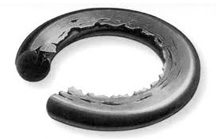
EXTRUSION OR NIBBLING
Description:
The seal develops ragged edges, generally on the low pressure side, which appear tattered. This condition is more common with high pressure systems
CONTRIBUTING FACTORS:
- Excessive clearances
- Excessive system pressure
- Irregular clearance gaps due to eccentricity
- Sharp groove edges
- Low-modulus/low-hardness elastomer
- Softening of elastomer due to fluid incompatibility
- Excessive gland fill
- Expansion of cylinder wall due to pressure
SUGGESTED SOLUTIONS:
- Decrease clearances
- Decrease system pressure if possible
- Use back-up ring
- Increase rigidity and concentricity of metal components
- Break edges of groove to minimum of .004" (0.10mm)
- Use higher-modulus/higher-hardness elastomer
- Use more chemically compatible elastomer
- Increase groove width or change o-ring size
- Stiffen cylinder wall to limit expansion
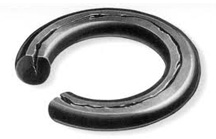
OVER-COMPRESSION
DESCRIPTION:
The seal exhibits parallel flat surfaces corresponding to the sealing surfaces, May also develop circumferential splits within flattened surfaces.
CONTRIBUTING FACTORS:
- Excess compression squeeze
- Elastomer with poor compression set properties
- Elastomer with inadequate heat resistance
- Elastomer that swells excessively in system fluid
- Improperly cured part used
SUGGESTED SOLUTIONS:
- Use smaller o-ring or adjust gland dimensions
- Use material with better compression set resistance
- Use more heat resistant elastomer
- Use more chemically resistant elastomer
- Check cure state of parts prior to installation
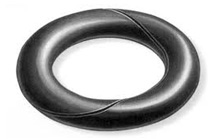
SPIRAL FAILURE
DESCRIPTION:
The seal surface exhibits a series of deep, spiral, 45° angle cuts. This failure is often seen with long stroke, hydraulic piston seals.
CONTRIBUTING FACTORS:
- Eccentric components
- Wide clearances in combination with side locks
- Uneven surface finishes
- Inadequate lubrication
- Elastomer is too soft
- Stroke speed too slow - dynamic reciprocating
SUGGESTED SOLUTIONS:
- Increase rigidity and concentricity of metal components
- Decrease clearances
- Machine metal surfaces to 10 to 20 pinch surface finish
- Specify an external lubricant or use an internally lubricated material
- Use a higher durometer material
- Increase stroke speed or use D-ring instead of O-ring
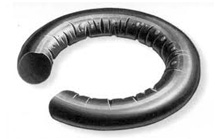
DESCRIPTION:
The seal may exhibit radical cracking on the highest temperature surfaces, often accompanied by the flattening of the seal characteristics of over-compression. Certain elastomers may exhibit signs of softening, such as a shiny surface.
CONTRIBUTING FACTORS:
SUGGESTED SOLUTIONS:
The seal may exhibit radical cracking on the highest temperature surfaces, often accompanied by the flattening of the seal characteristics of over-compression. Certain elastomers may exhibit signs of softening, such as a shiny surface.
CONTRIBUTING FACTORS:
- Thermal properties of elastomer
- Excessive temperatures, temperature excursions or temperature cycling
SUGGESTED SOLUTIONS:
- Select more heat-resistant elastomer
- Select elastomer containing antioxidants
- Consider possibility of cooling sealing surfaces
- Increase thermal mass to dampen temperature cycling or excursions
- Change the position of the gland away from heat source
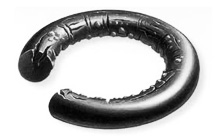
DESCRIPTION:
Explosive decompression results when high-pressure gases are absorbed by the seal, and then as the pressure is rapidly dropped, the expanding gases are trapped in the micropores of the elastomer, causing surface blisters and ruptures as they escape. The effected seals cross-section. When first removed the surface may also be covered with small blisters..
CONTRIBUTING FACTORS:
SUGGESTED SOLUTIONS:
Explosive decompression results when high-pressure gases are absorbed by the seal, and then as the pressure is rapidly dropped, the expanding gases are trapped in the micropores of the elastomer, causing surface blisters and ruptures as they escape. The effected seals cross-section. When first removed the surface may also be covered with small blisters..
CONTRIBUTING FACTORS:
- Rapid pressure drop from high pressure
- Low-modulus/low-hardness elastomer
SUGGESTED SOLUTIONS:
- Slow the release of system pressure
- Specify a higher-modulus/higher-hardness material
- Specify a decompression-resistant material
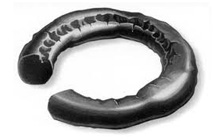
DESCRIPTION:
The seal may exhibit many signs of degradation including blisters, cracks, voids, or discoloration. However, in some cases the degradation is only detectable by measurement of physical properties.
CONTRIBUTING FACTORS:
SUGGESTED SOLUTIONS:
The seal may exhibit many signs of degradation including blisters, cracks, voids, or discoloration. However, in some cases the degradation is only detectable by measurement of physical properties.
CONTRIBUTING FACTORS:
- Incompatibility with chemical environment
SUGGESTED SOLUTIONS:
- Use more chemically resistant elastomer
- Use PTFE encapsulated o-ring
- Decrease temperature that o-rings sees, as higher temperatures accelerate chemical degradation
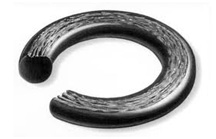
DESCRIPTION:
Abrasion occurs only with dynamic seals - seals involved with a rotary, oscillating or reciprocating motion. The seal or parts of the seal exhibit a single flat surface parallel to the direction of motion. Loose particles and scrapes may be found on the seal surface.
CONTRIBUTING FACTORS:
SUGGESTED SOLUTIONS:
Abrasion occurs only with dynamic seals - seals involved with a rotary, oscillating or reciprocating motion. The seal or parts of the seal exhibit a single flat surface parallel to the direction of motion. Loose particles and scrapes may be found on the seal surface.
CONTRIBUTING FACTORS:
- Rough sealing surface
- Sealing surfaces too smooth to allow for adequate lubrication
- Process environment containing abrasive particle
SUGGESTED SOLUTIONS:
- Use recommended gland surface finishes
- Eliminate abrasive components or protect seal from exposure to them
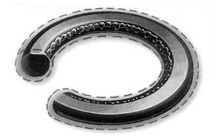
DESCRIPTION:
Seen primarily in fuel systems, plasticizer extraction is characterized by a loss of volume or weight of the seal. It is often difficult to detect with only a visual inspection
CONTRIBUTING FACTORS:
SUGGESTED SOLUTIONS:
Seen primarily in fuel systems, plasticizer extraction is characterized by a loss of volume or weight of the seal. It is often difficult to detect with only a visual inspection
CONTRIBUTING FACTORS:
- Heavy use of plasticizers to achieve low-temperature properties or hardness
- Exposure to organic solvents compatible with plasticizers used
SUGGESTED SOLUTIONS:
- Switch to elastomer with low-temperature properties so plasticizers aren't needed
- Change plasticizers used to ones less compatible with process fluids
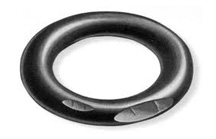
DESCRIPTION:
The seal or parts of the seal may exhibit small cuts, nicks or gashes.
CONTRIBUTING FACTORS:
SUGGESTED SOLUTIONS:
The seal or parts of the seal may exhibit small cuts, nicks or gashes.
CONTRIBUTING FACTORS:
- Sharp surfaces on glands or components
- Inadequate lead-in chamfer
- O-ring too large for gland
- Low-modulus/low-hardness elastomer
SUGGESTED SOLUTIONS:
- Break all sharp metal edges and cover threads with tubes or tape for installation
- Provides a 15° lead-in chamfer of adequate length so o-ring sees only chamfer
- Review gland and o-ring design per recommended designs standards
- Specify a higher-modulus/higher-hardness material
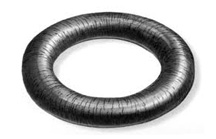
DESCRIPTION:
Occurring in seals exposed to ozone, UV radiation or other air pollutants, weather or ozone cracking is characterized by small surface cracks perpendicular to the direction of stress.
CONTRIBUTING FACTORS:
SUGGESTED SOLUTIONS:
Occurring in seals exposed to ozone, UV radiation or other air pollutants, weather or ozone cracking is characterized by small surface cracks perpendicular to the direction of stress.
CONTRIBUTING FACTORS:
- Exposure to ozone, UV radiation or other pollutants
- Excessive seal stretch (>5% ID stretch)
SUGGESTED SOLUTIONS:
- Select more ozone and UV-resistant elastomer
- Apply anti-ozonant or wax coating to seal
- Modify the design to avoid the damaging exposure
- Modify design to reduce stretch to less than 5%





